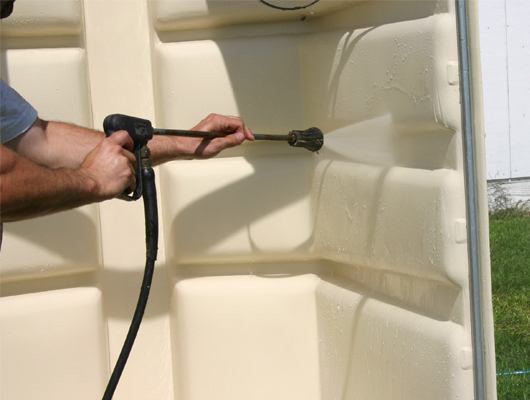By Kelly Driver
Most calf raisers will encounter crypto at some point. Crypto can be a source of frustration and heartache for calf raisers, as it is nearly impossible to completely remove and managing it requires diligent attention to cleanliness. While affected calves require a great deal of time and additional fluids for several days up to two weeks, the cost of dealing with crypto is more than just economic, the mental fatigue for calf care givers can also be grueling.
Here are some things we know about the dreaded Crypto and how best to combat it:
What is it? Cryptosporidium parvum is one of the most common parasites in dairy facilities. It is a protozoan parasite that at one stage of its life cycle forms egg-like bodies called oocysts. And as few as 100 of these oocysts can infect a calf, who in turn might produce up to 10 billion oocysts in a single day. As you can imagine, these oocysts contaminate everything they come in contact with – bedding, feed, water, and the hands and clothes of the calf raiser.
Once the crypto organisms are ingested by a calf, they cause damage to the large intestine and the end of the small intestine, destroying the inner lining of the intestine. This allows milk to pass through nearly undigested and the resulting diarrhea will typically be a yellowish to white color and may even appear foamy. (Lewis) Crypto most often shows up in calves between 7 to 28 days of age and presents as lethargic, weak calves with manure ranging from loose to watery. It may also contain blood, undigested milk, mucus or bile. (Hodges)
Who can best diagnose it? The herd veterinarian may make a diagnosis of c. parvum based on history and clinical signs, but a definitive diagnosis is often made with acid-fast stains of fecal samples at a local diagnostic lab. It is imperative to work closely with your herd veterinarian to minimize opportunities for c. parvum infections.
Where does it live? Cryptosporidium oocysts thrive in wet environments, like wet bedding and calving areas. The oocysts can live for up to a year in cool moist conditions (Leadley) and are resistant to drying and freezing. The parasite normally exists on most, if not all, dairy farms where calves are raised. Diligent attention and sanitation of the calving area and clean, dry, sanitized plastic calf housing and feed equipment can help to minimize the risk of infection. Calf-Tel housing products are made of polyethylene, a slick plastic that is easy to sanitize and clean and does not absorb bacteria.

What can be done for treatment? Calves affected with crypto will need fluid therapy to prevent dehydration, as well as electrolytes to replace those lost in the diarrhea. It is important to get calves to a clean, dry, and warm environment, preferably where they can be closely monitored throughout the duration of the illness. Feeding electrolytes is very important to keeping the calf hydrated and should be fed in addition to the normal feedings of milk or milk replacer.
Mortality is generally low with c. parvum, but morbidity is high and the calves will have a slower growth rate than unaffected calves. Calves that are otherwise healthy should recover in 5-10 days. In some cases, Cryptosporidium can be associated with other pathogens that occur in calves and result in more severe illness. (Quigley)
When can it be controlled? The best method of control is diligent attention to hygiene to keep oocyst numbers to a minimum. Wash, wash, wash your hands, clothing, feeding equipment and housing areas. Providing a clean, dry calving environment can help minimize the possibility of Crypto exposure, as the most common route of infection is through contact with infected feces or animals. “Research has shown that housing calves in clean, plastic hutches can reduce the prevalence of Cryptosporidium compared to housing calves in a calf barn, particularly if the barn has housed calves previously.” (Quigley)
Why is it tough to eradicate? Most dairy producers will deal with Cryptosporidium at some point and while there aren’t any definitive ways to eradicate it, proper hygiene and plastic Calf-Tel hutches or individual Calf-Tel pens can help to manage infection rates. Cryptosporidium oocysts are resistant to many disinfectants, including plain chlorine bleach, but can be killed by chlorine dioxide disinfectant delivered at the correct concentration and length of exposure. (Leadley)
Be extra vigilant. We always recommend regular consultation with your herd veterinarian to review calf health and facilities. Keep a notebook of things you notice daily and share these observations with the herd veterinarian.
And remember that older calves and people can also get C. parvum because it is a zoonotic disease. If anyone in your calf care team experiences similar symptoms, be sure to drink enough liquid to stay hydrated and if necessary, tell any medical providers of potential C. parvum exposure. Here at Calf-Tel we like healthy calves, but we know it’s equally important to keep the calf caregivers healthy too.
Sources
- Hodges, Rebecca. (Internet). Cryptosporidiosis in calves. Retrieved from https://www.vet.k-state.edu/docs/vhc/farm/ag-pract…
- Leadley, Dr. Sam. (Internet). Cryptosporidium parvum. Retrieved from http://atticacows.com//resources/calf-facts-resour…
- Lewis, Rob. (2016, January 19). Crypto presents a number of challenges. Manitoba Cooperator. Retrieved from https://www.manitobacooperator.ca/livestock/crypto-presents-a-number-of-challenges/
- Quigley, Dr. Jim. (1997, May 7). Calf Note #12 – Cryptosporidium & cryptosporidiosis. Retrieved from http://calfnotes.com/pdffiles/CN012.pdf
Courtesy of our dealer – CRI REPRODUCCIÓN ANIMAL MÉXICO SA DE CV.
